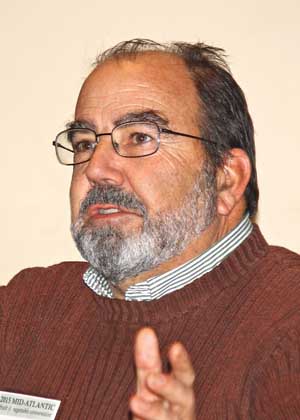How do fruit growers adjust spraying to fit the sizes of trees in their orchards?
“Trees have gotten smaller and canopy volume has decreased, but pesticide labels are still written in terms of so much per acre,” said Dean Polk, a Rutgers University entomologist who is its tree fruit IPM coordinator in New Jersey.
As products have gotten more expensive, growers have every reason to want to use less if they can and still feel assured they are getting adequate coverage and protection. Yet they are often frustrated when they seek advice.
“Extension people can’t make recommendations off the label,” Polk said. Not only is there potential liability, but growers themselves can’t afford to go off-label if they want companies to stand behind their products’ performance.
Still, growers can make adjustments that result in less active ingredient being applied per acre.
Polk moderated a panel discussion on the question involving three Eastern fruit growers during the Mid-Atlantic Fruit and Vegetable Convention.
The three are well known for their fruit growing proficiency. J.D. Rinehart grows 100 acres of peaches and 300 of apples near Smithsburg, Maryland, with his brother, John; Chris Baugher grows apples in Aspers, Pennsylvania; and Gary Mount and his wife, Pam, have 200 acres of fruits and vegetables they market directly from their farm, Terhune Orchards, in Princeton, New Jersey.
The old way
The standard spray recommendation was developed back in the days of large trees on seedling rootstocks. The recommendation for apples called for mixing the labeled rate of pesticide into 400 gallons of water, and that was to cover one acre to the point of liquid runoff. This was called a dilute spray, or 1X dilution.
However, researchers found growers didn’t need to haul that much water, and that fewer gallons could be used, so growers began using 2X, 3X, 4X, and 6X dilutions, cutting water to 200, 133, 100, or 76 gallons per acre—which would apply the label rate per acre in less water.
But as trees became smaller, growers cut gallons per acre as well, and that reduced the amount of active ingredient applied per acre. It all became quite complicated.

Chris Baugher
The Baugher way
“We moved to high density incrementally,” Chris Baugher said, “and that was not a good idea. Now we have all kinds of tree sizes and spacings, and we have to try to figure out how much to spray.”
Baugher said he starts with the advice given by the late tree fruit pathologist and entomologist Dr. Paul Steiner at University of Maryland.
Steiner, who died in 2000, recommended growers apply 0.09 gallons of low volume spray, where droplets were very small, for each 1,000 cubic feet of canopy volume, and use 0.7 gallons per 1,000 cubic feet of dilute spray where larger droplets would be applied and trees wetted to the drip point.
Baugher measured the height of the trees in various blocks, multiplying by the width of the trees and the length of the row.
The calculations gave him a general idea of how much canopy he had to spray in different blocks. He found he could simplify things to four application rates.
Using a 6X dilution, he sprays 50 gallons per acre “on my big old trees, same as Dad did,” 36 gallons per acre on dwarf and semi-dwarf trees, 25 gallons per acre on young dwarf plantings in their third and fourth leaf, and 13 gallons per acre on new, non-bearing plantings.
For peaches, he sprays everything 50 gallons per acre, 6X.
Baugher also uses a Raven SCS-330 sprayer control system—“cheap compared to smart sprayers”—and can further adjust application rate on the go by changing ground speed between 2.3 and 2.8 miles per hour.

J.D. Rinehart
The Rinehart way
J.D. Rinehart uses a smart sprayer. “That eliminates a lot of the issues,” he said.
The smart sprayer turns nozzles on or off, as the tree height gets taller or shorter, and turns all the nozzles off if there is no tree in the space to spray.
The sprayer operator drives at a consistent 3 mph. He has lowered the fan speed, reducing the power take-off speed from 540 revolutions per minute to 450, and uses a 3X dilution.
That dilution provides enough water so he gets better protection against bacterial spot in peaches, he said. And the peach tree canopy volume is controlled by pruning all trees to ten feet tall.
The Mount way
Gary and Pam Mount began their fruit enterprise 40 years ago, buying out an old farming operation that had big trees and old equipment.

Gary Mount
Like Baugher, he likes the Steiner rule of using 0.09 gallons per 1,000 cubic feet of canopy for low volume spraying, and has measured blocks to figure out their tree row volume. Large trees contain about 400,000 cubic feet of canopy per acre and dwarf trees about 160,000. He uses a 4X concentration.
He uses a tower sprayer with 25 nozzles on a side so he can adjust sprayer output according to tree volume.
In 2013, using his traditional method, he got apple scab, and that caused him to rethink his spraying practices. He had been using alternate-row middle (ARM) spraying, in which a high volume of air is used to blast spray through the tree and onto one side of the tree in the next row. It cuts the amount of spray time and travel by half.
After that resulted in scab, in 2014 he stopped using ARM and began spraying all trees from both sides. He also lowered the rpms at which the fan turned, from 540 to 380.
“The goal now is just to fill the tree with pesticide and air—and no more,” he said.
He also upped his gallons per acre from 36 to 50, thinking that, by spraying a few more gallons every row, he may also be able to lengthen the spray interval.
For this coming year, he plans to cut gallonage back to 36, but keep every-row spraying and the lower fan speed. •






I am wondering if anyone can recommend an inexpensive, but decent sprayer for a 200 semi dwarf orcahrd.